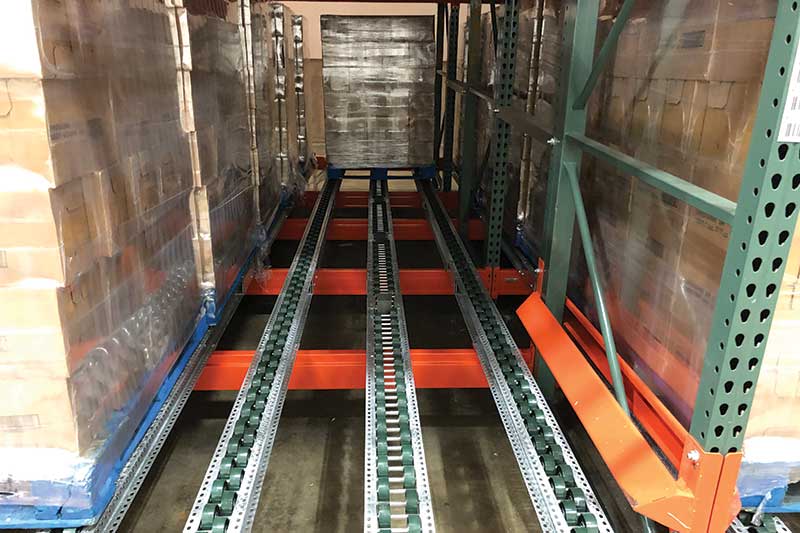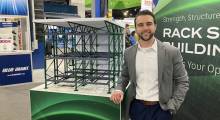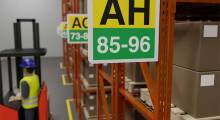Many food manufacturers have storage and material flow requirements that need to be able to handle the production of goods during busy harvest seasons, ideally keeping storage and production under one roof for efficiency.
Storing pallets on the floor can meet such seasonal storage needs, but when pallets can’t be stacked, this consumes warehouse space that can drive the need to purchase or lease off-site storage as product sales grow. GLK Foods, a Wisconsin-based manufacturer of sauerkraut and other foods products, faced this very challenge of finding a way to efficiently store materials for one of its sauerkraut product lines.
GLK Foods, family-owned for four generations, has grown into the largest kraut producer in the world and is known as an innovator of top-selling grab ’n go snacks. Growth has driven the company to implement some industry best practices for storage. The company implemented a pallet flow rack system (Steel King Industries) at its facility in Bear Creek, Wis., to store materials during the busy fall harvest in a space-efficient manner.
“We were looking to triple our available pallet storage and streamline production at our existing facility,” says Brad Froberg, plant manager for GLK Foods. “We run product year-round, but in the fall, as cabbage crops come in, we have to ramp up our production lines for a specialty kraut product.”
According to Froberg, previously pallet floor storage was used in the facility for this specialty kraut product. He notes that the product was not stackable, so the pallets were stored single file across the floor.
“The challenge was that inventory processing and inventory storage all went through the same room and became a production bottleneck,” says Froberg. “This led to leasing offsite storage and the inefficient double handling of product.”
The situation called for a storage rethink, culminating in GLK implementing a pallet flow rack system. Pallet flow rack systems can be multiple pallet positions high and deep, enabling dense, space-efficient storage that’s well suited to first-in, first-out (FIFO) inventory management.
To find options, Froberg consulted with Wolter (formerly Wisconsin Lift Truck), a materials handling distributor in the Midwest, whose representative Mark DeCleene recommended the pallet flow rack approach to streamline the facility’s available storage and related lift truck workflows.
The solution uses Steel King’s SK3400 Pallet Flow system. With pallet flow, dynamic flow rails are inclined in a static rack structure, allowing loads placed on one end to move by gravity on rollers to the unloading end, with speed controllers acting as gentle brakes.
When pallet flow is properly designed and installed, when each pallet load is removed, the pallets behind it move forward automatically. Once loaded, FIFO product rotation is automatic. Forklifts are only required for the initial loading and final unloading because the rack eliminates the labor and forklift operation required to arrange loads in traditional racking.
Because a dynamic flow system’s height, width and depth were limited only by the size of the facility and capabilities of the materials handling equipment, pallet flow rack was a good fit for GLK Foods’ high volume needs at the Bear Creek site.
To take full advantage of the facility’s vertical space, the pallet flow system was installed to a height of 27.5 feet. The system is five levels high and up to five pallet positions deep, storing up to 850 pallets. Access to the top racks is enabled by using a high-reach lift truck, as was recommended by the lift truck distributor.
The system, installed in 2020, was built with Steel King’s Closed Back Tubular Rack for strength and durability. Compared to open back roll-formed columns, the closed tubular uprights are 44 times more torsion/twist resistant, with 250% greater frontal impact resistance and 68% greater side impact resistance.
“We selected a robust racking system that’s able to resist forklift damage. By design, the closed back rack is safer, stronger and more durable than open back rack,” says Froberg.
A major benefit of the solution is its density, which reduces the need for off-site storage, further streamlining material flow.
“The pallet flow system has tripled storage space at our facility, while streamlining processing and production,” says Froberg. “We were able to increase our in-house storage capacity by about 25 trailer loads of product. So, we’re not shipping it to offsite storage, and then bringing it back again.”
According to Froberg, this approach eliminates the cost of leasing offsite storage space and eradicates the double-handling of product. “Over the fall harvest period, we’re probably saving about 150 hours of forklift double-handling alone,” he says.
The greater pallet storage density has opened up floor space. This enables putting more separation between product lines, while enhancing safety, productivity and cleanliness.
“The pallet flow system has eliminated our storage and production bottleneck and is improving our effectiveness,” says Froberg. “The storage consolidation will also help us accommodate future growth within our facility, which was previously not really possible.”
Article topics









